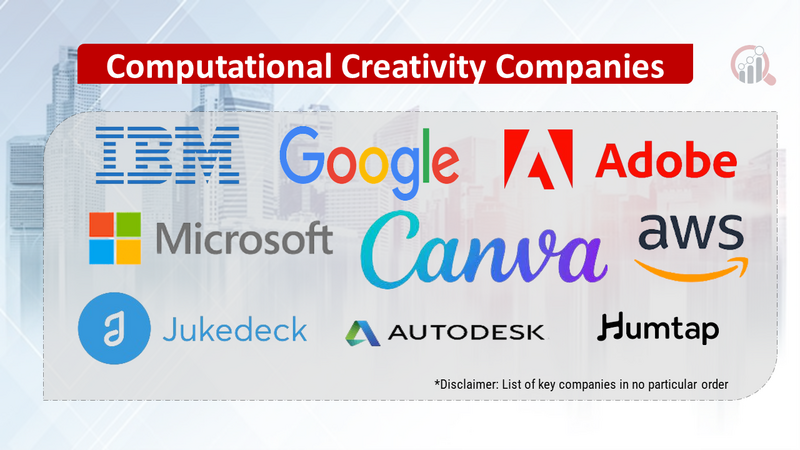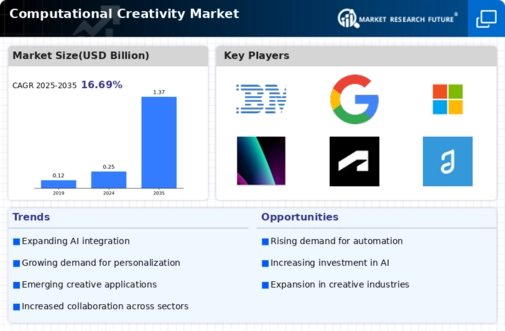Top Industry Leaders in the Computational Creativity Market

Computational Creativity Market: Dive into the Latest News and Updates
The human spark of creativity has long propelled progress and inspired awe. Now, the torch is being passed, with the Computational Creativity (CC) market emerging as a powerful force. By harnessing the power of algorithms and computing to mimic, augment, and even surpass human creative processes, this market is reshaping industries and igniting a new era of innovation.
Some of Computational Creativity Companies Listed Below:
- IBM (US)
- Google (US)
- Microsoft (US)
- Adobe (US)
- AWS (US)
- Autodesk (US)
- Jukedeck (UK)
- Humtap (US)
- Amper Music (US)
- Automated Creative (UK)
- ScriptBook (Belgium).
- B12 (US)
- The Grid (US)
- Canva (Australia)
- Hello Games (UK)
- Aiva (Luxembourg)
- Object Al (Hong Kong)
- Firedrop (UK)
- Obvious (France)
- Prisma Labs (US)
Strategies Fueling Growth:
-
AI and Machine Learning Integration: Deep learning algorithms for music composition, text generation, and image creation are the driving force behind the CC market, unlocking unprecedented levels of creative automation and exploration. -
Industry-Specific Solutions: Developing pre-trained models and tools tailored to specific sectors like advertising, product design, and scientific research accelerates adoption by addressing unique creative challenges and generating industry-relevant outputs. -
Human-AI Collaboration: CC tools are not meant to replace human creativity, but rather to augment it. Platforms that prioritize seamless interaction and empower human oversight build trust and encourage broader adoption. -
Accessibility and Ease of Use: User-friendly interfaces, drag-and-drop functionalities, and low-code development options remove technical barriers and democratize access to CC tools, fostering widespread innovation and experimentation.
Market Share Decoding: Key Factors to Consider:
-
Functionality and Feature Set: Platforms offering a diverse range of creative tools, integration with existing software, and support for various media formats attract businesses with wider creative needs and workflows. -
Performance and Scalability: The ability to handle large data volumes, generate outputs quickly, and adapt to different creative tasks efficiently is crucial for catering to demanding creative projects and large-scale adoption. -
Security and Data Privacy: Robust data security measures and compliance with regulations like GDPR and CCPA build trust and open doors to industries with stringent data protection requirements, particularly when dealing with sensitive creative content. -
Pricing and Deployment Options: Competitive pricing models, flexible subscription plans, and cloud-based or on-premise deployment options cater to diverse budget constraints and IT environments, making CC tools accessible to a wider user base.
New and Emerging Stars: Illuminating the Creative Path
-
Explainable AI and Interpretability: Companies like Lime are making CC algorithms more transparent, providing explanations for how creative outputs are generated, ensuring user trust and enabling informed creative decisions. -
Generative AI Marketplaces and Collaboration: Startups like Hugging Face are creating platforms for sharing and monetizing pre-trained AI models specifically for creative tasks, fostering collaboration and accelerating creative development.
Latest Company Updates:
-
Dec 15, 2023: Google AI unveils MuseNet, a new AI model that can generate music in different styles. -
Jan 2, 2024: OpenAI releases CLIP, a new AI system for generating creative images based on text descriptions. -
Jan 7, 2024: Adobe announces Project Onda, an AI-powered tool for creating personalized video content.









